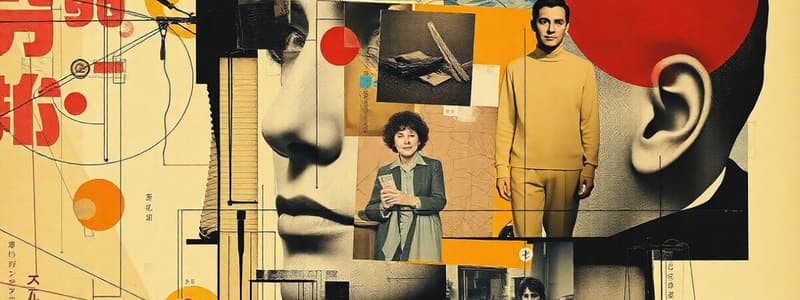Podcast
Questions and Answers
What do the two dimensions of emotion primarily consist of?
What do the two dimensions of emotion primarily consist of?
- Emotion-relevant behaviors and subjective experiences
- Physiological fingerprint and action tendencies
- Valence and arousal (correct)
- Cognitive appraisal and physiological response
According to the James-Lange theory, emotions arise from which of the following?
According to the James-Lange theory, emotions arise from which of the following?
- The environment's influence on arousal levels
- The simultaneous occurrence of physiological arousal and emotion
- Unconscious evaluations of emotional stimuli
- The perception of physiological responses to stimuli (correct)
What is a key argument made by Cannon and Bard against the James-Lange theory?
What is a key argument made by Cannon and Bard against the James-Lange theory?
- Some emotional experiences occur before physiological responses (correct)
- Emotions are both delayed and caused by physiological responses
- Physiological responses operate independently of emotions
- Every emotion correlates with a unique physiological fingerprint
The two-factor theory of emotion suggests that arousal is interpreted in different ways depending on what?
The two-factor theory of emotion suggests that arousal is interpreted in different ways depending on what?
Which system of the nervous system is primarily responsible for physiological arousal?
Which system of the nervous system is primarily responsible for physiological arousal?
How does task difficulty affect the optimal level of arousal for performance?
How does task difficulty affect the optimal level of arousal for performance?
Which theory suggests that emotional experiences and bodily responses occur simultaneously but independently?
Which theory suggests that emotional experiences and bodily responses occur simultaneously but independently?
What aspect of the two-factor theory has been both supported and contradicted by modern research?
What aspect of the two-factor theory has been both supported and contradicted by modern research?
What would the James-Lange theory imply about the relationship between emotions and physiological responses?
What would the James-Lange theory imply about the relationship between emotions and physiological responses?
What does the drive-reduction theory propose about motivation?
What does the drive-reduction theory propose about motivation?
Which of the following correctly describes self-actualization in Maslow's hierarchy of needs?
Which of the following correctly describes self-actualization in Maslow's hierarchy of needs?
What is a significant limitation of the polygraph as a lie detection tool?
What is a significant limitation of the polygraph as a lie detection tool?
What does terror management theory suggest people do to cope with the fear of death?
What does terror management theory suggest people do to cope with the fear of death?
Which statement best explains the facial feedback effect hypothesis?
Which statement best explains the facial feedback effect hypothesis?
What role do the lateral and ventromedial hypothalamus play in hunger regulation?
What role do the lateral and ventromedial hypothalamus play in hunger regulation?
Which motivation type refers to seeking positive outcomes and rewards?
Which motivation type refers to seeking positive outcomes and rewards?
Why might extrinsic motivation sometimes undermine intrinsic motivation?
Why might extrinsic motivation sometimes undermine intrinsic motivation?
Which factor can influence hunger based on psychological aspects?
Which factor can influence hunger based on psychological aspects?
Which hormones are primarily involved in regulating sexual motivation?
Which hormones are primarily involved in regulating sexual motivation?
Flashcards
Two Dimensions of Emotion
Two Dimensions of Emotion
Emotions are characterized by valence (how positive the feeling is) and arousal (how energetic the feeling is).
James-Lange Theory
James-Lange Theory
Feelings are the perception of physiological responses to a stimulus.
Cannon-Bard Theory
Cannon-Bard Theory
Emotions and bodily arousal happen simultaneously, but independently.
Two-Factor Theory
Two-Factor Theory
Signup and view all the flashcards
Appraisal
Appraisal
Signup and view all the flashcards
Action Tendencies
Action Tendencies
Signup and view all the flashcards
Sympathetic Nervous System
Sympathetic Nervous System
Signup and view all the flashcards
Optimal Arousal
Optimal Arousal
Signup and view all the flashcards
Arousal & Task Difficulty
Arousal & Task Difficulty
Signup and view all the flashcards
Valence
Valence
Signup and view all the flashcards
Yerkes-Dodson Law
Yerkes-Dodson Law
Signup and view all the flashcards
Polygraph
Polygraph
Signup and view all the flashcards
Emotional Expression
Emotional Expression
Signup and view all the flashcards
Display Rules
Display Rules
Signup and view all the flashcards
Facial Feedback Effect
Facial Feedback Effect
Signup and view all the flashcards
Motivation
Motivation
Signup and view all the flashcards
Intrinsic Motivation
Intrinsic Motivation
Signup and view all the flashcards
Obesity
Obesity
Signup and view all the flashcards
Maslow's Hierarchy
Maslow's Hierarchy
Signup and view all the flashcards
Self-actualization
Self-actualization
Signup and view all the flashcards
Study Notes
Emotion
- Emotion is a temporary state involving subjective experiences, physiological activity, and action tendencies.
- Two dimensions of emotion:
- Valence: positivity of the feeling
- Arousal: energy level of the feeling
Theories of Emotion
- James-Lange Theory: Emotions arise from the perception of physiological responses to a stimulus (feeling is a consequence, not a cause).
- Cannon-Bard Theory: Emotions and bodily arousal occur simultaneously and independently. Some emotional responses precede physiological reactions. Stimuli can cause bodily responses without necessarily creating an emotion.
- Two-Factor (Schachter-Singer) Theory: Stimuli trigger general physiological arousal, which is then interpreted as a specific emotion based on context (one physiological response can be interpreted differently based on situation).
Modern Research on Emotion
- Modern research partially supports aspects of the two-factor theory but contradicts other aspects.
Arousal and Performance
- Sympathetic Nervous System: Activates the body's "fight-or-flight" response, responsible for arousal.
- Yerkes-Dodson Law: Performance is optimal at a moderate level of arousal.
- Simple tasks: High arousal can boost performance.
- Complex tasks: Low arousal is better for focus and avoiding stress.
Polygraph
- A device measuring physiological responses believed to indicate lying.
- Measures heart rate, blood pressure, respiration, and skin conductivity (sweating).
- Unreliable: Physiological responses can be caused by anxiety, not just deception.
Emotional Expression
- Emotional expression: Observable signs of emotion (facial expressions, tone, body language).
- Most powerful nonverbal means of conveying emotion: facial expressions (over 10,000 unique expressions).
- Display Rules: Social and cultural norms dictating how, when, and where emotions should be expressed.
- Examples: Some cultures encourage public smiling, others discourage it in specific contexts.
- Facial Feedback Effect: Hypothesis that facial expressions directly influence emotional experience.
- Example: Smiling can make you feel happier.
Motivation
- Motivation: Internal causes of purposeful behavior, driving needs and desires (e.g., hunger, social connection).
- Instinct: Natural tendency to seek a goal, hard-wired.
- Approach Motivation: Drive toward positive outcomes (rewards).
- Avoidance Motivation: Drive to avoid negative outcomes, often stronger than approach motivation.
- Drive-Reduction Theory: Organisms motivated to reduce internal drives (like hunger, thirst) to maintain equilibrium.
- Hedonic Principle: People seek pleasure and avoid pain.
- Maslow's Hierarchy of Needs: Prioritizes needs based on basic to complex requirements.
- Physiological needs > Safety needs > Social needs > Esteem needs > Self-actualization needs. Self-actualization is achieving one’s full potential—personal growth, creativity, and fulfilling purpose.
Hunger
- Hunger driven by body’s energy needs.
- Hypothalamus: Plays a key role in regulating hunger.
- Lateral hypothalamus: Signals to turn hunger "on."
- Ventromedial hypothalamus: Signals to turn hunger "off."
- Hormones like ghrelin (hunger) and leptin (satiety) also influence hunger.
- Psychological factors (stress, emotions), and cultural factors (food preferences, traditions) affect hunger.
Eating Disorders and Obesity
- Eating Disorders:
- Binge-eating disorder (BED): Uncontrolled eating episodes.
- Bulimia nervosa: Binge eating followed by compensatory behaviors (e.g., purging).
- Anorexia nervosa: Severe restriction of food.
- Obesity: BMI of 30 or higher; associated with health risks and social stigma.
Sexual Motivation
- Hormones (testosterone, estrogen) key drivers of sexual motivation.
Achievement Motivation
- Drive to excel, achieve goals, and overcome challenges.
Motivation Types
- Intrinsic Motivation: Internal rewards (satisfaction, enjoyment).
- Extrinsic Motivation: External rewards (money, recognition).
- Extrinsic rewards can sometimes undermine intrinsic motivation.
Terror Management Theory
- People are motivated to manage the fear of death by upholding cultural beliefs and pursuing self-esteem.
Studying That Suits You
Use AI to generate personalized quizzes and flashcards to suit your learning preferences.




